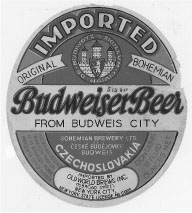Budweiser Budvar is a Czech beer brewed in the southern Bohemian town of České Budějovice, a town better known outside the Czech Republic under its old German name of Budweis. It’s the town’s name that gives a clue to the reason why, for more than a century, there has been a long and bitter legal battle between two producers of beers labelled “Budweiser.”
Anheuser-Busch InBev, the American brewer of Budweiser, claims that its beer is the original.

Anheuser Busch and the Budvar Brewery in the Czech town of České Budějovice, also known as Budweis, have fought a protracted legal battle over the rights to the Budweiser trademark. pike microbrewery museum, seattle, wa
The Anheuser-Busch brewery in St Louis opened in 1875, owned by two German emigrants, Eberhard Anheuser and Adolphus Busch. Among their portfolio of beers was one labeled “Budweiser,” and in subsequent court cases, the company admitted its beer was based on the Bohemian beers. When sales of American Budweiser grew, it was marketed, with classically American bravado, as the “King of Beers”—not too dissimilar from the “Beer of Kings.” In 1895, Czech speakers in Budweis banded together to build a rival to the town’s German brewery, Burgerbrau. The new company was called the “Budějovicky Pivovar” meaning the “Budweis Brewery,” but this was contracted to “Budvar” for convenience.
When the Czech company attempted to export its beer to the United States, a series of court cases ensued. At first, Budvar was banned from exporting to the United States using the Budweiser trademark, but there were no restrictions on their use of the mark in Europe. However, since the end of World War II, the two companies have fought protracted battles to establish their respective brands throughout the world. The company that manages to register its trademark first can use the full Budweiser label. In some countries the American beer can only be sold as “Bud,” whereas the Czech version is known in some markets as Budějovicky Budvar as a result of losing a court case to Anheuser-Busch. The Czech brewery is still state-owned more than 2 decades after the fall of communism. Successive Czech governments have said they will only privatize the brewery if they can find a “suitable partner,” a phrase widely understood not to include their nemesis, Anheuser-Busch. But steps are being taken to turn the brewery into a joint stock company, the first steps to privatization.
Budvar bears little resemblance to the American beer of the same name. It has 5% alcohol by volume and 20 units of bitterness and is one of the few remaining large brands still made by the traditional lagering method involving a very slow secondary fermentation. The beer adheres to the German Reinheitsgebot or Purity Law that stipulates that only malted barley, hops, yeast, and water can be used in the brewing process. Budvar is brewed in a particularly beautiful traditional brew house with copper mashing and boiling vessels set on tiled floors. A double decoction mash is used.
Only pale Moravian malt and Žatec (Saaz) whole hops are used. Soft brewing water comes from a deep natural lake beneath the brewery, using a well that dates back several thousand years. The finished beer is refreshing, showing a rich malt and vanilla aroma, and fine, floral hop character. The finish has a fine balance of juicy malt, tangy hop resins, and a delicate hint of apple fruit. The beer retains the deep burnished gold color that is among the hallmarks of the Bohemian pilsner style.
Budvar also brews a 4% version of the beer for the domestic market. In recent years it has added an amber lager called Pardal (Panther) aimed at blue-collar drinkers and sports enthusiasts. Following a major debate within the brewery, Budvar has also added Dark, a black lager of the type produced in central Europe before the advent of modern malting techniques. It has been a success in the Czech Republic and is exported to Britain where some pubs have a special dispense system that mixes golden Budvar and Dark, a mixture known as “Half and Half.”
There has been some slight softening in the dispute between Anheuser-Busch and Budvar, with A-B Inbev distributing the Czech beer in the United States under the name Czechvar. In the Czech Republic both Budvar and the older Burgerbrau brewery—known for some years as Samson but now called the Town Brewery—have been granted a guarantee of origin by the European Union that entitles both companies to use the Budweiser trademark.
